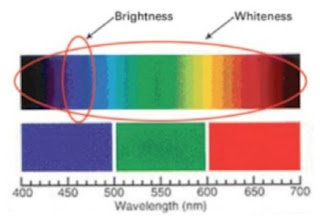- Brightness: Defined roughly as the amount of blue-white reflectance compared with magnesium oxide, which is considered 100% bright.
- Whiteness: The extent to which paper diffusely reflects light of all wavelengths throughout the visible spectrum. The assigned ideal white standard totally reflects all light throughout the spectrum.

When paper is bleached, the spectral reflectance curve increases the most in the blue and violet range, at about the 457nm point. This has also made the measurement of brightness well suited for measuring the aging of paper because paper yellows with age. Most white papers are in the 60 to 90% brightness range.
Paper brightness requirements for ISO 12647-2. Currently there are no specifications for ISO 12647-3 (newsprint), ISO 12647-4 (gravure), ISO 12647-5 (screen printing), or ISO 12647-6 (flexo).
Paper brightness requirements for ISO 12647-2. Currently there are no specifications for ISO 12647-3 (newsprint), ISO 12647-4 (gravure), ISO 12647-5 (screen printing), or ISO 12647-6 (flexo).
The beginning brightness range for a base paper pulp is from 0-100, but during the papermaking process, optical brightening agents (OBAs) are frequently added to improve a paper’s brightness. The function of an OBA is to reflect ultraviolet (UV) light from the light source as visible light in the blue spectral region. On very bright sheets, this can create a situation where there is more reflected visible light from the surface of the paper than the light source emits, resulting in a measurement in excess of 100.
Whiteness, on the other hand, refers to the extent to which paper reflects equally the light of all wavelengths throughout the visible spectrum. A truly white sheet of paper will not absorb one wavelength of light energy more than another.
For example, if a sheet of paper is placed under a full spectrum light, most of that light will be reflected back equally and the paper will appear white.
 However, if some of the wavelengths of light energy are absorbed, the color of the paper will shift to the light which was not absorbed, but was instead reflected back to the viewer. That is why a red sheet of paper appears red in white light because it absorbs all the other colors and reflects only the red.
However, if some of the wavelengths of light energy are absorbed, the color of the paper will shift to the light which was not absorbed, but was instead reflected back to the viewer. That is why a red sheet of paper appears red in white light because it absorbs all the other colors and reflects only the red.Most white papers will have a total reflectance between 50% and 90% with variations as high as 20 to
30% at different wavelengths.
In North America, brightness is the most commonly referenced term used outside the industry itself.
However, in Europe and other parts of the world, whiteness is the more common reference.
Unfortunately, there is no correlation between a paper’s brightness level and its whiteness level. They are based on different measurement systems.
Shade - the color of the paper - is the third factor that impacts one’s visual perception of paper. Shade is typically measured using the universally accepted CIE LAB model.
--------------
Do you have a color management question, horror story or event to share?
Email me at reilley4color@gmail.com
Do you have a color management question, horror story or event to share?
Email me at reilley4color@gmail.com
No comments:
Post a Comment
Got a comment, or correction? Please let us know!